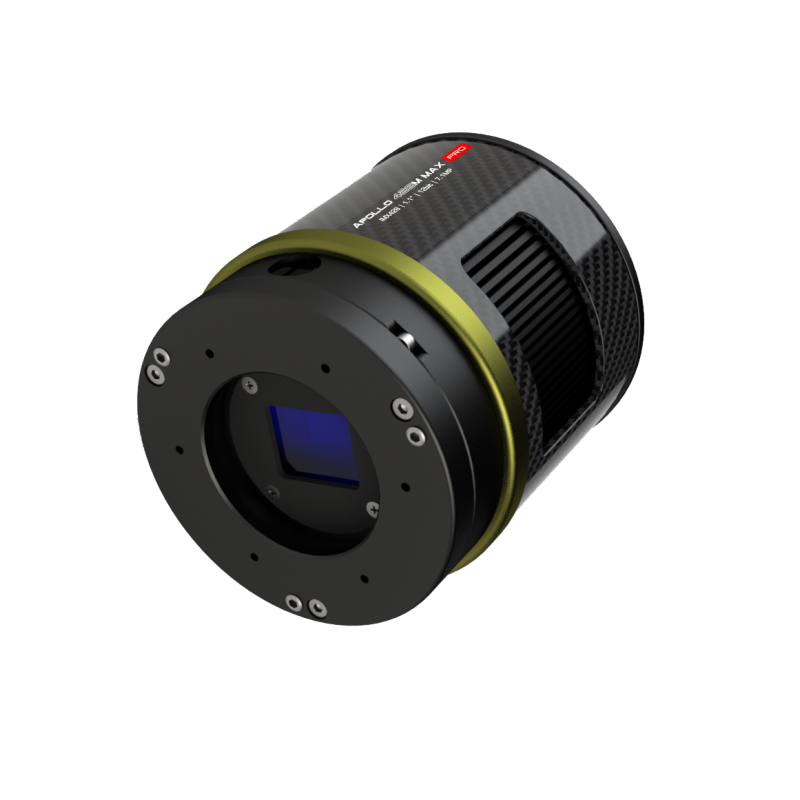- Promo !

Référence: ZWEAF-N
Marque: ZWO
Référence: POA-URANUS-C
Marque: Player One
Référence: POA-ACS
Marque: Player One
Référence: AS-FRA400
Marque: ASKAR - Sharpstar
Référence: ZWASI120MINI
Marque: ZWO
Référence: AS-SET-DUO-D1D2
Marque: ASKAR - Sharpstar
Référence: ZWDC-Y-SPLIT
Marque: ZWO
Référence: AS-REDFRA400
Marque: ASKAR - Sharpstar
Moyen de payement







Nouvelle caméra Planétaire/Solaire au capteur IMX428 Mono
 SECURITE
SECURITE
Payement 100% Sécurisé
 EXPEDITION
EXPEDITION
Expédition Express des pièces en stock
 POLITIQUE DE RETOUR
POLITIQUE DE RETOUR
Retour sous 14 j
La ligne de caméra refroidie par DSO est la gamme de produits la plus avancée de l'histoire du joueur. Nous commençons le projet à partir de 2021, grâce à beaucoup de modifications et de reconstruction, nous avons fait cette version finale. Il apporte notre nouvelle technologie et notre conception à tout le monde, nous sommes très fiers de présenter cette gamme de caméras.
L'APOLLO 428M MAX Pro Camera est développée par Player One Astronomy, une véritable caméra refroidie pour l'imagerie solaire. APOLLO-M MAX Pro Camera, qui adopte le capteur monochrome de format Sony IMX428 1,1 ”. La taille de pixel 4.5um peut accueillir une profondeur de puits de 25,3 ke avec un total de 7,1 MP (la résolution est de 3216 * 2208), et la diagonale est de 17,5 mm.


La Apollo 428m Max (IMX428) est basé sur Pregius 3rd Generation. IMX428 est une version haute résolution d'IMX432, il a 4.5UM, et bien est de 25ke. Mais si vous utilisez le mode BIN2, IMX428 aura 9UM Pixel et bien sûr le plein jusqu'à 4x (100ke).
Apollo 428m Max (IMX428) a un format de 1,1 ″, identique à Apollo-M Max. Il est assez grand, presque deux fois de la puce IMX174.

La Apollo 428m Max (IMX428) a un format de 1,1 ″, identique à la Apollo-M Max. Il est presque deux fois plus grand que la puce IMX174.

Comme nous le savons, La Apollo 428M Max Pro a une taille de pixel 4.5UM, la demi-taille de la Apollo-M Max. Si nous utilisons BIN2elle ressemblera plus à une Apollo-M MAX et 3 combinaison de BIN est possible avec ses propres avantages:
Cutting-edge Design
The Apollo 428M MAX Pro cooled camera using same design as Ares cooled series, but a little difference! With a round body, a golden and black color scheme, and using carbon fiber to keep weight down and cutting-edge outlook. We also integrated the sensor tilter plate and anti-dew PCB board. This series of designs makes the camera not only light and cool, but also functional!

When shooting deep sky objects, the sensor tilt plate can be used to adjust the sensor tilt angle to make the stars at the corners more rounded. Apollo 428M MAX Pro camera provide both front and Rear tilter plate fulfill all usage scenarios

is the default part on camera, we believe most users has experience with this before. it works well in a lot of basic scenarios.
is an alternate part for camera, when use filter wheel/filter drawer and OAG with fixed angel, it is necessary. And it is also convenient for RASA users to adjust the sensor tilt angel.
The built-in high-density sponge shading pad can block the light from the side slits without any side leakage.
The Apollo 428M MAX Pro uses a carbon fiber in camera hausing and has been optimized for weight reduction in its structural design. The camera weighs only 420 grams, making it one of the lightest models on the market.

Player One cooled camera series use 2 Stage TEC Cooling unit, after improved the structure design to reject the heat back to camera chamber, Camera Delta-T can reach 35-40℃.

In the design of lightweight cooled cameras, Player One still pursuing the perfection, any necessary features must have, especially anti-dew system, is the problem that a lot of small cooled cameras ignored.

HCG mode will automatic open when Gain ≥70, readout noise will drop to 2.4e. And dynamic range will rise to 12 drops again.
At 450 gain, readout noise of Apollo 428M MAX Pro camera is 1.4e, it is lower than IMX432.
Apollo 428M MAX Pro is not a non-amp-glow camera, but it’s amp-glow is very smooth, we believe it will be easier to be calibrated. In solar imaging, it won’t be a problem at all.
300s@gain=0, -10 degree, Dark frame of Apollo 428M MAX Pro

512MB DDR3 Cache
As an improvement, DDR3 cache in cooled cameras are increased to 512MB. It helps stabilize and secure data transmission, it effectively avoids frame dropping and greatly reduces readout noise.
With the DDR3 cache, the camera does not have high demands on computing needs any longer, it will still has excellent performance even if it is connected to a USB 2.0 port.

Back piece of cooled camera has 2 Type-C data port and 12V DC 5.5×2.1mm power port.

Main data port support USB3.0 protocol, the camera can run 51fps under RAW8 mode. Type-C port is easier to plug in when assemble the imaging equipment in night.
When recording images, since the actual writing speed will be affected by the writing speed of the hard disk itself, when the hard disk writing speed is slow, the recording may not reach the theoretical speed. It is recommended that you use a high-quality solid state drive to record data to give full play to the performance of the camera.
The camera has 12V DC5.5*2.1mm port to provide enough power to TEC cooling system. If you don’t need to power up cooling, only need to connect the main Type-C port, the camera will works as a uncooled camera.

In ASCOM window, we provide 3 adjustable parameters: Target temperature, Fan Speed and Anti-Dew power.
Standard Delta-T : 35℃-40℃ (Long exposure mode), 30℃(Video mode), when ambient temp 30℃, fan speed 100%, dew heater 1%.
Recommend Delta-T settings: 30℃-35℃ below ambient, fan speed 50-70%, dew heater 10%, power consumption 40- 60%.
The rotation speed of cooling fan is also adjustable, the default value is 50% speed.
Dew problem is the biggest enemy in astro imaging, the camera integrated anti-dew heater in front of the camera. The heat power is adjustable.

The planetary cameras from Player One Astronomy have DPS (Dead Pixel Suppression) technology. The DPS is anaylse many dark frames to find out thoes fixed abnormal pixel and record the map in camera memory. In imaging, each exposure frames, thoes position of dead pixels will be given a median value according to the active pixels around that abnormal pixel.

Player One cameras produced by the number one player ensures the safety of your camera and other equipment through overvoltage and overcurrent protection mechanisms.

Regarding readout noise, we solemnly promise that all values are obtained from actual tests. And for users, you could use Sharpcap 4 for testing. SC4 has a function called Sensor Analysis, provide a very simple way to test readout noise.
We wrote a tutorial on our website: https://player-one-astronomy.com/service/manuals/
If you are interested in readout noise testing, you may try it yourself, which is very simple.
The dark current is 0.08e/s/pix at -20℃, and 0.1e/s/pix at 0℃.



Following is some recommend 55mm BFL solution for this camera. If don’t consider about BFL, the connection way is various.




Aucun avis n'a été publié pour le moment.
Référence: ZWASI2600MC-AIR
Marque: ZWO
Référence: ZWASI183MM-P
Marque: ZWO
Référence: C1P-3000ACouleur
Marque: Moravian
Référence: ZWASI294MC-P
Marque: ZWO
Référence: POA-APOLLO-M-MAX-PRO-EX
Marque: Player One
Référence: ZWASI2600MM-P25
Marque: ZWO
Référence: ZWASI533MM-P
Marque: ZWO
Référence: C1P-5000AMono
Marque: Moravian
Référence: ZWASI2400MC-P
Marque: ZWO
Référence: ZWASI294MM-P
Marque: ZWO
Référence: ZWASI533MC-P
Marque: ZWO
Référence: POA-ARES-C-PRO
Marque: Player One
Référence: C1P-EFW-7000AM48
Marque: Moravian
Référence: POA-ARES-M-PRO
Marque: Player One
Référence: ZWASI183MC-P
Marque: ZWO
Référence: POA-URANUS-M-PRO
Marque: Player One
Référence: POA-OAG-MINI
Marque: Player One
Référence: POA-PW8X125
Marque: Player One

Nouvelle caméra Planétaire/Solaire au capteur IMX428 Mono
check_circle
check_circle